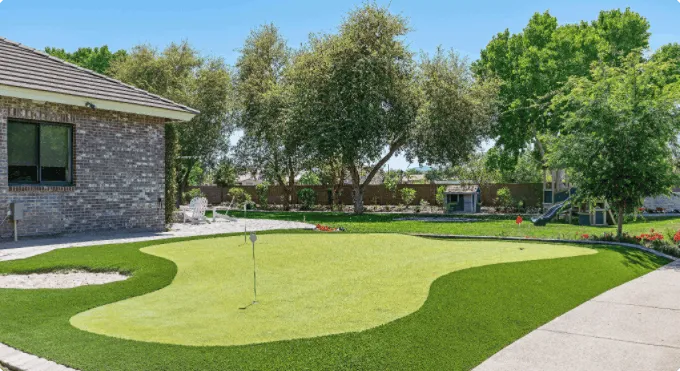
- Afrikaans
- Arabic
- Belarusian
- Bengali
- Czech
- Danish
- Dutch
- English
- Esperanto
- Estonian
- Finnish
- French
- German
- Greek
- Hindi
- Hungarian
- Icelandic
- Indonesian
- irish
- Italian
- Japanese
- kazakh
- Rwandese
- Korean
- Kyrgyz
- Lao
- Latin
- Latvian
- Malay
- Mongolian
- Myanmar
- Norwegian
- Persian
- Polish
- Portuguese
- Romanian
- Russian
- Serbian
- Spanish
- Swedish
- Tagalog
- Tajik
- Thai
- Turkish
- Turkmen
- Ukrainian
- Urdu
- Uighur
- Uzbek
- Vietnamese
Benefits of Artificial Grass for Landscape Design and Maintenance
Nov . 10, 2024 14:12 Back to list
The Growing Popularity of Artificial Grass Landscaping
In recent years, the trend of installing artificial grass in residential and commercial landscapes has surged in popularity. This synthetic alternative to natural grass offers several advantages that make it an appealing choice for homeowners, landscape designers, and businesses alike. As urban environments continue to expand and the demand for sustainable landscaping solutions grows, understanding the benefits and applications of artificial grass is essential for making informed decisions about landscaping projects.
Sustainability and Environmental Benefits
One of the most significant advantages of artificial grass is its sustainability. Traditional lawns require regular maintenance, including watering, mowing, and the application of fertilizers and pesticides, all of which can have detrimental effects on the environment. Conversely, artificial grass eliminates the need for irrigation, helping conserve water resources, particularly in areas prone to drought. In fact, research shows that households can save thousands of gallons of water per year by opting for synthetic grass over natural lawns.
Moreover, artificial grass is produced using recyclable materials, and many manufacturers now offer eco-friendly options. The longevity of synthetic turf—often lasting between 15 to 25 years—means it contributes less waste to landfills compared to the cycle of installing, maintaining, and replacing natural grass. This sustainability angle plays a crucial role in the growing acceptance of artificial grass as an environmentally responsible landscaping choice.
Aesthetic Appeal and Versatility
Aesthetically, artificial grass provides a consistently lush, green appearance year-round, unaffected by weather conditions or heavy foot traffic. Homeowners can enjoy a beautiful lawn without the challenges of seasonal changes, pests, or diseases that often plague natural grass. This feature is particularly attractive for families with children and pets, as synthetic turf can withstand heavy use and still maintain its visual appeal.
Furthermore, artificial grass is not limited to traditional lawn applications. It can be creatively employed in a variety of settings, from residential yards and rooftop gardens to commercial properties and playgrounds. The versatility of artificial turf means it can be customized to fit different styles and purposes, whether one is looking to create a serene garden oasis, a functional sports area, or a vibrant outdoor space for entertaining.
artificial grass landscaping

Cost-Effectiveness Over Time
While the initial investment in artificial grass can be higher than that of natural grass, many homeowners and businesses find the long-term savings to be significant. The reduction in maintenance costs—such as lawn care services and water bills—can offset the initial purchase and installation costs within a few years. Additionally, synthetic grass requires minimal upkeep, often just a periodic brushing and occasional rinsing to keep it clean and functional.
In commercial settings, businesses that install artificial grass can create attractive, low-maintenance outdoor spaces that enhance their brand image without the ongoing costs of natural landscaping. This makes it an appealing option for retail establishments, hotels, and event venues seeking to enhance the outdoor experience for customers and guests.
Health and Safety Considerations
Artificial grass has also gained traction for its health and safety benefits. It is often made from non-toxic materials, making it a safe choice for children and pets. Many modern installations involve padded underlays that provide cushioning to reduce the risk of injuries during falls. Furthermore, synthetic turf is designed to be resistant to pests, reducing the need for harmful chemicals and creating a healthier outdoor environment.
Conclusion
As the world becomes increasingly aware of environmental issues and the need for sustainable living practices, artificial grass landscaping presents a compelling alternative to traditional lawns. Its aesthetic appeal, versatility, cost-effectiveness, and safety features make it an attractive option for a wide range of applications. Whether for residential use or commercial development, the shift towards artificial grass signifies a new era in landscape design—one that harmonizes beauty, functionality, and environmental responsibility. Embracing artificial grass can lead to a greener, cleaner, and more efficient future for our outdoor spaces.
-
The Benefits of Artificial Turf for Indoors
NewsJul.15,2025
-
How Artificial Grass Suppliers Ensure Quality Products
NewsJul.15,2025
-
Artificial Grass and Pets: A Space for Relaxation
NewsJul.08,2025
-
Balcony & Outdoor Decoration with Artificial Grass
NewsJul.08,2025
-
Best Indoor Artificial Grass for Home
NewsJul.07,2025
-
Best Pet Turf for Dogs: Safe & Durable Artificial Grass Options
NewsJul.07,2025
Products categories









